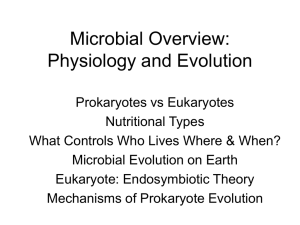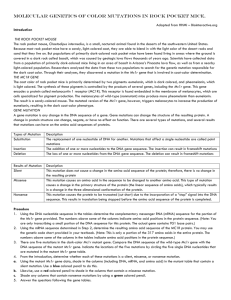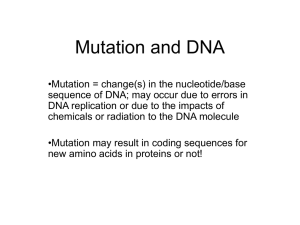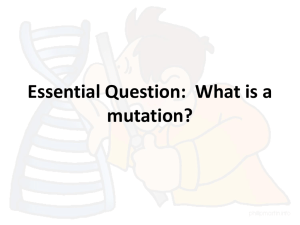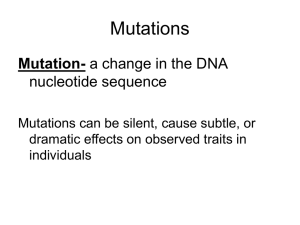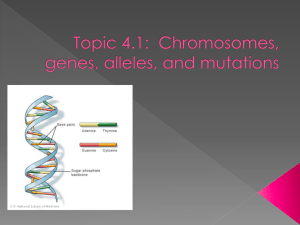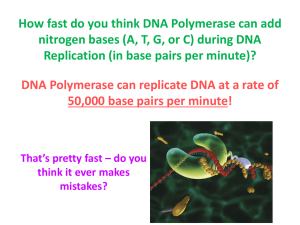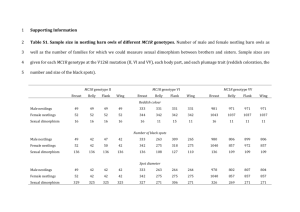Understanding the Theory of Evolution Isn`t
advertisement
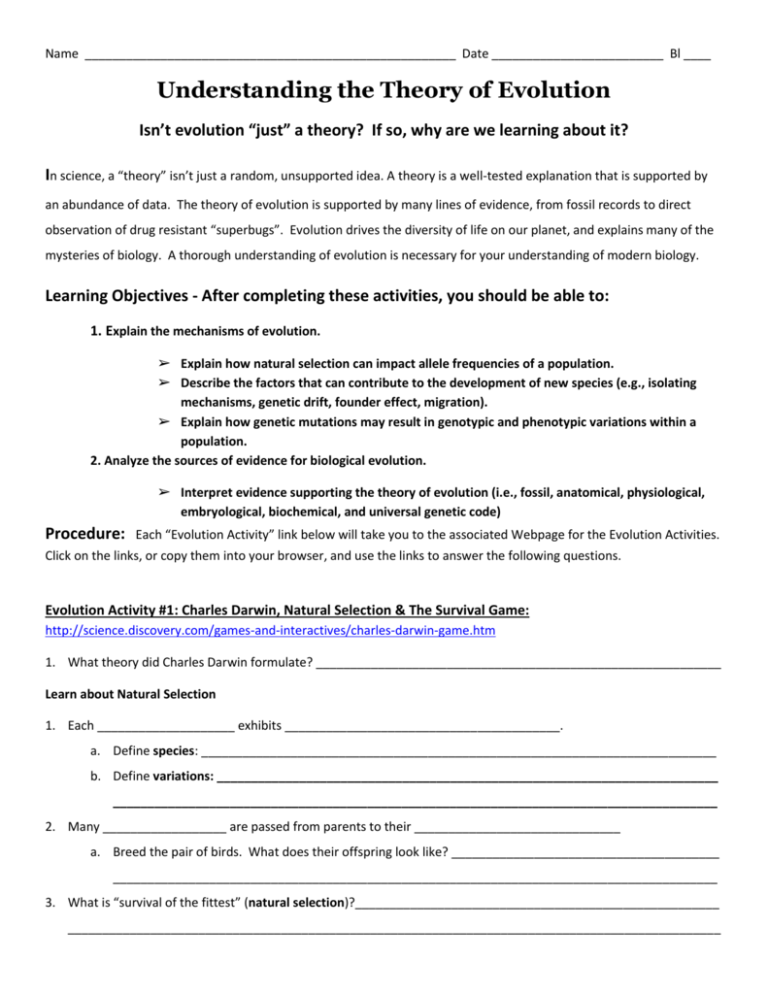
Name ______________________________________________________ Date _________________________ Bl ____ Understanding the Theory of Evolution Isn’t evolution “just” a theory? If so, why are we learning about it? In science, a “theory” isn’t just a random, unsupported idea. A theory is a well-tested explanation that is supported by an abundance of data. The theory of evolution is supported by many lines of evidence, from fossil records to direct observation of drug resistant “superbugs”. Evolution drives the diversity of life on our planet, and explains many of the mysteries of biology. A thorough understanding of evolution is necessary for your understanding of modern biology. Learning Objectives - After completing these activities, you should be able to: 1. Explain the mechanisms of evolution. ➢ Explain how natural selection can impact allele frequencies of a population. ➢ Describe the factors that can contribute to the development of new species (e.g., isolating mechanisms, genetic drift, founder effect, migration). ➢ Explain how genetic mutations may result in genotypic and phenotypic variations within a population. 2. Analyze the sources of evidence for biological evolution. ➢ Interpret evidence supporting the theory of evolution (i.e., fossil, anatomical, physiological, embryological, biochemical, and universal genetic code) Procedure: Each “Evolution Activity” link below will take you to the associated Webpage for the Evolution Activities. Click on the links, or copy them into your browser, and use the links to answer the following questions. Evolution Activity #1: Charles Darwin, Natural Selection & The Survival Game: http://science.discovery.com/games-and-interactives/charles-darwin-game.htm 1. What theory did Charles Darwin formulate? ___________________________________________________________ Learn about Natural Selection 1. Each ____________________ exhibits ________________________________________. a. Define species: ___________________________________________________________________________ b. Define variations: _________________________________________________________________________ ________________________________________________________________________________________ 2. Many __________________ are passed from parents to their ______________________________ a. Breed the pair of birds. What does their offspring look like? _______________________________________ ________________________________________________________________________________________ 3. What is “survival of the fittest” (natural selection)?_____________________________________________________ _______________________________________________________________________________________________ 4. What will happen to an organism that is born with traits that help it survive? ________________________________ _______________________________________________________________________________________________ 5. What will eventually happen to those traits? __________________________________________________________ Survival Game: The goal of the game is to live 1,000,000 years. 1. Select three “variants” to start your population. Remember, certain characteristics make it easier for your organism to survive in its environment. You can see more phenotypes for starter population by clicking on “more mutations.” Describe your original population: Starter organism #1: _______________________________________________________________________ Starter organism #2: _______________________________________________________________________ Starter organism #3: _______________________________________________________________________ 2. What happens to the animals as the environment changes? ______________________________________________ _______________________________________________________________________________________________ 3. Environment change #1: __________________________________________________ Did you use a mutation to get a better adapted phenotype into your population _______; if so, what mutation did you use and why? ______________________________________________________________ ________________________________________________________________________________________ 4. Environment change #2: __________________________________________________ Did you use a mutation to get a better adapted phenotype into your population _______; if so, what mutation did you use and why? ______________________________________________________________ ________________________________________________________________________________________ 5. Environment change #3: __________________________________________________ Did you use a mutation to get a better adapted phenotype into your population _______; if so, what mutation did you use and why? ______________________________________________________________ ________________________________________________________________________________________ 6. Play three times to see how long you can get your animals to live. What’s your record? __________________ 7. Why did certain phenotypes (traits) die in your population? ______________________________________________ _______________________________________________________________________________________________ What phenotypes were selected against (NOT beneficial to organisms)? _____________________________ ________________________________________________________________________________________ 8. Why did certain phenotypes (traits) survive in your population? __________________________________________ _______________________________________________________________________________________________ What adaptations were selected for (allowed organisms to survive)? ________________________________ ________________________________________________________________________________________ Evolution Activity #2: Similarities and Differences: Understand homology and analogy: http://evolution.berkeley.edu/evolibrary/article/0_0_0/similarity_hs_01 1. Define homology - ________________________________________________________________________________ What is a common ancestor? ________________________________________________________________ ___________________________________________________________________________________________ 2. Define analogy - __________________________________________________________________________________ What does convergent evolution mean? ______________________________________________________ ___________________________________________________________________________________________ Tale of the Limb 1. Play the game. What are some similarities among the limbs? _____________________________________________ __________________________________________________________________________________________________ The Tetrapod Limb 1. What is tetrapod? ________________________________________________________________________________ 2. Name 4 bones found in the limbs of different organisms. _________________________________________________ __________________________________________________________________________________________________ Inheriting Homologies 1. How can whales, lizards, humans and birds be so different, but have the same basic limb layout? _________________ __________________________________________________________________________________________________ 2. What are homologous structures? ___________________________________________________________________ __________________________________________________________________________________________________ Homologies are Everywhere 1. How are leaves of an Oak and leaves of a Gingko homologous? ____________________________________________ __________________________________________________________________________________________________ 2. How are the wings of a dragonfly and wings of a butterfly homologous? ____________________________________ __________________________________________________________________________________________________ Beyond the Obvious 1. Explain how evolution adapted the incisors (teeth) of a beaver and elephant to perform different functions. _______ __________________________________________________________________________________________________ Not All Similarity is Homology 1. Define an analogous structure. ______________________________________________________________________ __________________________________________________________________________________________________ 2. Using the evolutionary tree and the explanation beneath, give an example of two organisms who have analogous structures. ________________________________________________________________________________________ Analogies 1. Is the sabertooth that is present on each of the skulls an example of a homology? Why or why not? ______________ __________________________________________________________________________________________________ __________________________________________________________________________________________________ How Do Analogies Evolve? 1. The birds are attracted to the red flower. Overtime, how do the yellow and pink flowers evolve to become more attractive to the bird? _______________________________________________________________________________ 2. Why do the yellow and pink flowers want to attract the bird? _____________________________________________ Homology or Analogy? 1. Name four ways a shark is different from a dolphin. _____________________________________________________ __________________________________________________________________________________________________ 2. Are the sharks and dolphins similarities homologies or analogies? Explain. __________________________________ __________________________________________________________________________________________________ Studying Homologies and Analogies 1. How do scientists determine if the trait is a homology or analogy? _________________________________________ __________________________________________________________________________________________________ Using Homologies to Reconstruct Relationships 1. Based on the evolutionary tree, what evidence suggests that humans, chimpanzees, and gorillas are more closely related then any of them are to the panda? ______________________________________________________________ __________________________________________________________________________________________________ **********Complete the Test Your Understanding section on the computer********** Evolution Activity #3: Speciation http://evolution.berkeley.edu/evolibrary/article/0_0_0/evo_40 1. Read the introduction. Click on “next” 2. What is a species? __________________________________________________________________ _________________________________________________________________________________ 3. Why are the populations of “Happy Face” spiders considered to be the same species, even though they look different? __________________________________________________________ 4. Read the remainder of the page. Click “Next” 5. What is speciation? ___________________________________________________________________________ 6. Describe what happened to the population of fruit flies on a tropical island: a. Setting the scene: ____________________________________________________________ ___________________________________________________________________________ b. Disaster strikes: ______________________________________________________________ ________________________________________________________________________ i. Has speciation occurred? ______________ Why or why not? __________________ ____________________________________________________________________ c. The populations diverge: i. Why do the two populations (mainland and island) evolve differently? ___________ ____________________________________________________________________ ii. Looking at the picture below, describe how the island flies (on left) differ from the mainland flies (on right): 1. Island flies: _________________________________________________ 2. Mainland flies: _________________________________________________ d. So we meet again: Another storm reintroduces the island flies to the mainland i. Will the island flies mate with the mainland flies? ____________ Why or why not? ___________________________________________________________________ ii. Are the two populations of flies still the same species? _________. Why or why not? _______________________________________________________________ 7. Click on “Reproductive Isolation” on the left side menu. 8. Reproductive Isolation: the inability of two populations to mate and product viable (living) fertile (able to reproduce) offspring. Populations that are reproductively isolated are NOT the same species. 9. List the three barriers (bullet points) that can lead to reproductive isolation (speciation): a. ___________________________________________________________________________ b. ___________________________________________________________________________ c. ___________________________________________________________________________ 10. Scroll down to read about what likely happened to the island and mainland fruit flies. Explain how the island population of fruit flies may have evolved differently than the mainland fruit flies. ___________________________________________________________________________ ___________________________________________________________________________ ___________________________________________________________________________ ___________________________________________________________________________ ___________________________________________________________________________ ___________________________________________________________________________ Go to : http://www.hhmi.org/biointeractive/anole-lizards-example-speciation View the video and answer the following questions 1. When are two organisms considered to be different species? 2. How can one species split into two? 3. Anole lizards use dewlaps as a mating characteristic. Dewlaps are the colorful flap of skin on male’s chins. a. What happens to the dewlaps of a population of Anole lizards living in bright environments? b. What would happen if the two populations were reintroduced? Would females still recognize the males with differently colored dewlaps? c. What is reproductive isolation? 4. What drives the evolution of different body types in species living the same area? 5. How does natural selection help the spread of species to different habitats? 6. What happens to the lizard bodies over many generations? Why? Evolution Activity #4: What did T-Rex Taste Like? http://www.ucmp.berkeley.edu/education/explorations/tours/Trex/index.html 1. Click on “Student start.” Use the drop-down menu to select Folder 3 2. What do cladograms show? ________________________________________________________________________ _______________________________________________________________________________________________ 3. What is more closely related to caimans? Hares or parrots? __________________________ Why? ______________ _______________________________________________________________________________________________ 4. What do cladograms represent? ____________________________________________________________________ _______________________________________________________________________________________________ a. What are these relationships based on? _______________________________________________________ ________________________________________________________________________________________ 5. Complete the following table for the animal cladogram. Associate each letter with the appropriate characteristic: A. D. B. E. C. F. 6. Which feature do frogs, humans, hares, caimans, and parrots share? _______________________________________ 7. Which feature do humans, hares, caimans, and parrots share that the other three lineages did not inherit? __________________________________________________________________________ 8. How can scientists use fossils to determine how closely related two species are? _____________________________ _______________________________________________________________________________________________ 9. Continue to folder 4 10. What do each of the following symbols mean in a features table? a. + = _______________________________________________ b. 0 = _______________________________________________ c. – = _______________________________________________ d. ? = _______________________________________________ 11. Click on each “character” or trait in the cladogram. As you click on each feature, the table at the top of the cladogram updates. Use this table as a guide to complete the features table below using the symbols above: 12. Click on “update” when finished to check your table. 13. Complete the features table ( +, - , 0, ? ) on the right for the “zoomed in” part of the cladogram: Remember to click “update” to check your work. 14. Is the “hair” feature of the T-Rex important in figuring out who the T-Rex is most closely related to? _________ Why or why not? __________________ _______________________________________________________________ 15. Does the T-Rex have an opening in front of his eye (colored green)? ___________________ What other animals does he share this characteristic with? _______________________________________________________________ 16. Based on the features we have examined, who can we hypothesize that T. rex is most closely related to? _________________________________ 17. Fill in the cladogram by writing characteristics on the branches and organisms across the top: 18. What did T-rex taste like? ________________________________________________ 19. What evidence did we use to determine what T-Rex tasted like? __________________________________________ _______________________________________________________________________________________________ 20. Because T-Rex was bipedal and had a reduced number of fingers, what can we infer? _________________________ _______________________________________________________________________________________________ _______________________________________________________________________________________________ _______________________________________________________________________________________________ Evolution Activity #5: Rock Pocket Mice - a living example of Darwin’s natural selection. http://www.hhmi.org/biointeractive/making-fittest-natural-selection-and-adaptation INTRODUCTION: The tiny rock pocket mouse weighs just 15 grams, about as much as a handful of paperclips. A typical rock pocket mouse is just about 170 millimeters long from nose to rump, shorter than an average pencil. Their impact on science, however, has been enormous. What’s so special about these little mice? Populations of rock pocket mice are found all over the Sonoran Desert in the southwestern United States. There are two common varieties—a light-colored variety and a dark-colored variety. Similarly, there are two major colors of substrate, or surface materials, that make up the desert floor. Most of the landscape consists of light-colored sand and rock. Here and there, however, separated by several kilometers of light-colored substrate, are patches of dark volcanic rocks that formed from cooling lava flows. The different coloration of the mice allow for camouflage from predators on the different desert floors. These mice provide the perfect system for studying how natural selection can impact allele frequencies of a population and how genetic mutations may result in genotypic and phenotypic changes in a population over time. Rock Pocket Mice Part 1 Procedure: Answer the following questions as you watch the 10 minute video here: http://www.hhmi.org/biointeractive/makingfittest-natural-selection-and-adaptation Environmental change often drives evolution. 1. What major change happened to the landscape in the Valley of Fire ~ 1000 years ago? ___________________ __________________________________________________________________________________________ 2. Rock pocket mice are the “snickers bar” of the desert. Name 3 predators that eat them. __________________________________________________________________________________________ 3. What is the pocket mouse’s mechanism of evading predators? _________________________________ __________________________________________________________________________________________ 4. What happened to the population of mice living on the dark lava over time?____________________ __________________________________________________________________________________________ Mutation is the primary source of new alleles (genes which code for new traits) in a population. 5. How did the dark mice appear?______________________________________________________________ 6. Mutation is ______________________________________________________________________________ 7. Mutation occurs when there is a c____________________ e___________________ during cell division. 8. Is the following statement true or false? Justify your answer in one or two sentences: “The same mutation could be advantageous in some environments but deleterious in others.” ____________________________________________________________________________________________ ____________________________________________________________________________________________ ____________________________________________________________________________________________ 9. Is the following statement true or false? Justify your answer in one or two sentences: “The appearance of darkcolored volcanic rock caused the mutation for black fur to appear in the rock pocket mouse population.” ____________________________________________________________________________________________ ____________________________________________________________________________________________ ____________________________________________________________________________________________ Adaptations can spread quickly through a population, changing the allele frequency of that population. 10. An adaptation is a trait the provides a selective advantage, increasing the “fitness” of the organism. If the dark fur adaptation provides a 1% advantage, it will take ______________ years to become present in 95% of the population. If it provides a 10% advantage, it will take over the mouse population in _____________ years. 11. What is the selective force that is driving this change in allele frequency? __________________________ 12. A common misconception is that evolution is a random process. ___________________ is a random process, but natural selection is not. Natural selection selects the w_____________________. 13. Explain how the environment plays a role in changing the frequency of a mutant allele in a population. ____________________________________________________________________________________________ ____________________________________________________________________________________________ ____________________________________________________________________________________________ Rock Pocket Mice Part 2: Molecular Genetics of Color Mutations in Rock Pocket Mice - A review of transcription, translation and mutations! (Adapted from http://www.hhmi.org/biointeractive/molecular-genetics-color-mutations-rock-pocket-mice) Background: Researchers have analyzed the data from these two populations of rock pocket mice to search for the genetic mutation responsible for the dark coat color. Through their analyses, they discovered a mutation in the Mc1r gene that is involved in coat-color determination. THE MC1R GENE: The coat color of rock pocket mice is primarily determined by two pigments: eumelanin, which is dark colored, and pheomelanin, which is light colored. The synthesis of these pigments is controlled by the products of several genes, including the Mc1r gene. This gene encodes a protein called melanocortin 1 receptor (MC1R). This receptor is found embedded in the membrane of melanocytes, which are cells specialized for pigment production. The melanocytes of wild-type (nonmutant) mice produce more pheomelanin than eumelanin. The result is a sandy-colored mouse. The mutated version of the Mc1r gene, however, triggers melanocytes to increase the production of eumelanin, resulting in the dark coat-color phenotype. GENE MUTATION : A gene mutation is any change in the DNA sequence of a gene. Gene mutations can change the structure of the resulting protein. A change in protein structure can change, negate, or have no effect on function. There are several types of mutations, and several results that mutations can have on the amino acid sequences of proteins. Types of Mutations : Substitution mutation: The replacement of one nucleotide of DNA for another. Mutations that affect a single nucleotide are called point mutations. Insertion mutation: The addition of one or more nucleotides to the DNA gene sequence. The insertion of nucleotides can result in frameshift mutations. Deletion mutation: The loss of one or more nucleotides from the DNA gene sequence. The deletion of nucleotides can result in frameshift mutations. Potential Results a Gene Mutation Has on a Protein : Silent mutation: This mutation does not cause a change in the amino acid sequence of the protein; therefore, there is no change in the resulting protein. Missense mutation: This mutation causes an amino acid in the sequence to be changed to another amino acid. This type of mutation causes a change in the primary structure of the protein (the linear sequence of amino acids), which typically results in a change in the three-dimensional conformation of the protein. Nonsense mutation: This mutation causes the protein to be truncated (cut short) due to the incorporation of a “stop” signal into the DNA sequence. This results in translation being stopped before the amino acid sequence of the protein is completed. PROCEDURE 1. Using the DNA nucleotide sequence in the gene tables below, determine the complementary messenger RNA (mRNA) sequence for the portions of the Mc1r gene provided. (Note: You are only transcribing a small portion of the DNA sequence for this protein. The actual gene contains 951 base pairs and the protein is 317 amino acids long.) The numbers above some of the columns indicate amino acid positions in the protein sequence. Also indicated is whether the sequence codes for an extracellular, intracellular, or transmembrane part of the protein. 2. Using the mRNA sequence determined in Step 1, determine the resulting amino acid sequence of the MC1R protein. (Note: This is only a portion of the 317 amino acids in the entire protein. The numbers above some of the columns in the tables indicate amino acid positions in the whole protein sequence.) You may use the genetic code chart provided in your textbook or the one below. 3. There are five mutations in the dark-color Mc1r mutant gene. Compare the DNA sequence of the wild-type Mc1r gene with the DNA sequence of the mutant Mc1r gene. Indicate the locations of the five mutations by circling the five single DNA nucleotides that are mutated in the mutant Mc1r gene table. 4. From the introduction, determine whether each of these mutations is a silent, missense, or nonsense mutation. Questions: 1. Using the amino acid numbers provided above the first and last column of each table, list the locations of the five amino acids that contain a mutation. _______ _______ _______ _______ _______ 2. Of the five mutations you identified in the Mc1r gene, how many are the following: _____ substitutions _____ insertions _____ deletions (Enter a number on each line.) 3. Of the five mutations you identified in the Mc1r gene, how many are the following: _____ silent _____missense _____ nonsense (Enter a number on each line.) 4. Which four amino acid locations (see Question 1 above) contain the missense mutations? _______, _______, _______, _______ 5. Explain the link between DNA sequence and protein structure and function. _____________________________________________________________________________ _____________________________________________________________________________ 6. Using the information on mutations in the introduction and your knowledge of proteins, develop a hypothesis to explain how the changes in the MC1R protein’s amino acid sequence might affect its function. _____________________________________________________________________________ _____________________________________________________________________________ _____________________________________________________________________________ 7. Where is the MC1R protein found, and what is its function? Be specific. ______________________________ 8. _____________________________________________________________________________ Evolution Activity #5: Solving the Mystery of the Neanderthals: http://www.geneticorigins.org/mito/media2.html 1. What are used as the molecular clock to measure human evolution? _______________________________________ _______________________________________________________________________________________________ 2. What happens when two groups split from a common ancestor? __________________________________________ _______________________________________________________________________________________________ a. The longer the two groups of organisms (ex: humans & chimpanzees) have been separated the ( more / fewer) mutations exist. 3. Human DNA is blue, chimpanzee DNA is red. Compare the DNA sequences to determine how many nucleotide differences exist: __________________ 4. How many mutations exist (on average) between two living humans? ___________________ a. Using this data, we can make a scale relating the number of mutations & how long it’s been since two groups shared a common ancestor. b. Seven mutations = _______________________________________ years 5. How many DNA mutations exist between Neandertal DNA & human DNA? ______________________ 6. How many years since humans and Neandertals shared a common ancestor? ________________________________ 7. Using mtDNA (mitochondrial DNA) data, explain why it is unlikely that Neandertals are closely related to any group of humans? _____________________________________________________________________________________ _______________________________________________________________________________________________ _______________________________________________________________________________________________ EXTRA CREDIT: http://humanorigins.si.edu/evidence/genetics/ancient-dna-and-neanderthals/neanderthalmitochondrial-dna Read the above article and describe the effect of these new revelations about interbreeding on the notion of “species” and what implications it carries for Homo sapien and Homo neanderthalenis.
